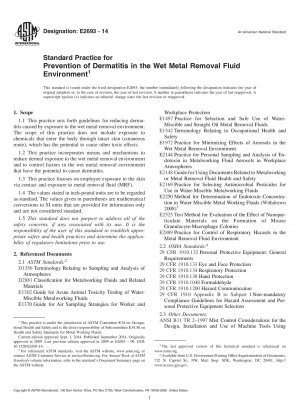ASTM E2693-14
Standard Practice for Prevention of Dermatitis in the Wet Metal Removal Fluid Environment
- Standard No.
- ASTM E2693-14
- Release Date
- 2014
- Published By
- American Society for Testing and Materials (ASTM)
- Status
- Replace By
- ASTM E2693-19
- Latest
- ASTM E2693-19
- Scope
5.1 Use of this practice is intended to reduce occupational dermatitis caused by exposure to the wet metal removal environment.
5.2 Complaints of dermatitis conditions are often associated with exposures to metal removal fluid.
5.3 Implementation of this practice and incorporation of metal removal fluid management program has the potential to reduce complaints of occupational dermatitis. Elements of an effective program include: understanding dermatitis and associated causes; prevention of dermatitis and exposure to metal removal fluids; appropriate product selection; good management of additives, microorganisms, and fluids; appropriate additive (including antimicrobial pesticides) selection and additive control; appropriate tool design and assessment and control of metal removal fluid exposures including aerosols.
1.1 This practice sets forth guidelines for reducing dermatitis caused by exposure to the wet metal removal environment. The scope of this practice does not include exposure to chemicals that enter the body through intact skin (cutaneous route), which has the potential to cause other toxic effects.
1.2 This practice incorporates means and mechanisms to reduce dermal exposure to the wet metal removal environment and to control factors in the wet metal removal environment that have the potential to cause dermatitis.
1.3 This practice focuses on employee exposure to the skin via contact and exposure to metal removal fluid (MRF).
1.4 The values stated in inch-pound units are to be regarded as standard. The values given in parentheses are mathematical conversions to SI units that are provided for information only and are not considered standard.
1.5 This standard does not purport to address all of the safety concerns, if any, associated with its use. It is the responsibility of the user of this standard to establish appropriate safety and health practices and determine the applicability of regulatory limitations prior to use.
ASTM E2693-14 Referenced Document
- ASTM D1356 Standard Terminology Relating to Sampling and Analysis of Atmospheres*, 2024-04-20 Update
- ASTM D2881 Classification of Metal Working Fluids and Related Materials
- ASTM E1302 Standard Guide for Acute Animal Toxicity Testing of Water-Miscible Metalworking Fluids
- ASTM E1370 Standard Guide for Air Sampling Strategies for Worker and Workplace Protection
- ASTM E1497 Standard Practice for Selection and Safe Use of Water-Miscible and Straight Oil Metal Removal Fluids
- ASTM E1542 Standard Terminology Relating to Occupational Health and Safety
- ASTM E1972 Standard Practice for Minimizing Effects of Aerosols in the Wet Metal Removal Environment
- ASTM E2144 Standard Practice for Personal Sampling and Analysis of Endotoxin in Metalworking Fluid Aerosols in Workplace Atmospheres
- ASTM E2148 Standard Guide for Using Documents Related to Metalworking or Metal Removal Fluid Health and Safety
- ASTM E2169 Standard Practice for Selecting Antimicrobial Pesticides for Use in Water-Miscible Metalworking Fluids
- ASTM E2250 Standard Method for Determination of Endotoxin Concentration in Water Miscible Metal Working Fluids
- ASTM E2525 Standard Test Method for Evaluation of the Effect of Nanoparticulate Materials on the Formation of Mouse Granulocyte-Macrophage Colonies
- ASTM E2889 Standard Practice for Control of Respiratory Hazards in the Metal Removal Fluid Environment
ASTM E2693-14 history
- 2019 ASTM E2693-19 Standard Practice for Prevention of Dermatitis in the Wet Metal Removal Fluid Environment
- 2014 ASTM E2693-14 Standard Practice for Prevention of Dermatitis in the Wet Metal Removal Fluid Environment
- 2009 ASTM E2693-09 Standard Practice for Prevention of Dermatitis in the Wet Metal Removal Fluid Environment
